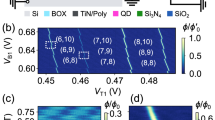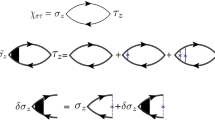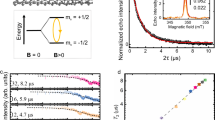Abstract
The manipulation and readout of spin qubits in quantum dots have been successfully achieved using Pauli blockade, which forbids transitions between spin–triplet and spin–singlet states1. Compared with spin qubits realized in III–V materials2,3,4,5, group IV materials such as silicon and carbon are attractive for this application because of their low decoherence rates (nuclei with zero spins)6,7. However, valley degeneracies in the electronic band structure of these materials combined with Coulomb interactions reduce the energy difference between the blocked and unblocked states8,9,10, significantly weakening the selection rules for Pauli blockade. Recent demonstrations of spin qubits in silicon devices have required strain and spatial confinement to lift the valley degeneracy7. In carbon nanotubes, Pauli blockade can be observed by lifting valley degeneracy through disorder11,12,13,14, but this makes the confinement potential difficult to control. To achieve Pauli blockade in low-disorder nanotubes, quantum dots have to be made ultrasmall8,9, which is incompatible with conventional fabrication methods. Here, we exploit the bandgap of low-disorder nanotubes to demonstrate robust Pauli blockade based on both valley and spin selection rules. We use a novel stamping technique to create a bent nanotube, in which single-electron spin resonance is detected using the blockade. Our results indicate the feasibility of valley–spin qubits in carbon nanotubes.
This is a preview of subscription content, access via your institution
Access options
Subscribe to this journal
Receive 12 print issues and online access
$259.00 per year
only $21.58 per issue
Buy this article
- Purchase on Springer Link
- Instant access to full article PDF
Prices may be subject to local taxes which are calculated during checkout




Similar content being viewed by others
References
Ono, K., Austing, D. G., Tokura, Y. & Tarucha, S. Current rectification by Pauli exclusion in a weakly coupled double quantum dot system. Science 297, 1313–1317 (2002).
Petta, J. R. et al. Coherent manipulation of coupled electron spins in semiconductor quantum dots. Science 309, 2180–2184 (2005).
Koppens, F. H. L. et al. Driven coherent oscillations of a single electron spin in a quantum dot. Nature 442, 766–771 (2006).
Nowack, K. C., Koppens, F. H. L., Nazarov, Y. & Vandersypen, L. M. K. Coherent control of a single electron spin with electric fields. Science 318, 1430–1433 (2007).
Nadj-Perge, S., Frolov, S. M., Bakkers, E. P. A. M. & Kouwenhoven, L. P. Spin–orbit qubit in a semiconductor nanowire. Nature 468, 1084–1087 (2010).
Bulaev, D. V., Trauzettel, B. & Loss, D. Spin–orbit interaction and anomalous spin relaxation in carbon nanotube quantum dots. Phys. Rev. B 77, 235301 (2008).
Maune, B. M. et al. Coherent singlet–triplet oscillations in a silicon-based double quantum dot. Nature 481, 344–347 (2012).
Wunsch, B. Few-electron physics in a nanotube quantum dot with spin–orbit coupling. Phys. Rev. B 79, 235408 (2009).
Secchi, A. & Rontani, M. Coulomb versus spin–orbit interaction in few-electron carbon-nanotube quantum dots. Phys. Rev. B 80, 041404 (2009).
Steele, G. A., Gotz, G. & Kouwenhoven, L. P. Tunable few-electron double quantum dots and Klein tunnelling in ultraclean carbon nanotubes. Nature Nanotech. 4, 363–367 (2009).
Buitelaar, M. R. et al. Pauli spin blockade in carbon nanotube double quantum dots. Phys. Rev. B 77, 245439 (2008).
Churchill, H. O. H. et al. Electron–nuclear interaction in 13C nanotube double quantum dots. Nature Phys. 5, 321–326 (2009).
Churchill, H. O. H. et al. Relaxation and dephasing in a two-electron 13C nanotube double quantum dots. Phys. Rev. Lett. 102, 166802 (2009).
Chorley, S. J. et al. Transport spectroscopy of an impurity spin in a carbon nanotube double quantum dot. Phys. Rev. Lett. 106, 206801 (2011).
Hanson, R., Kouwenhoven, L. P., Petta, J. R., Tarucha, S. & Vandersypen, L. M. K. Spins in few-electron quantum dots. Rev. Mod. Phys. 79, 1217–1266 (2007).
Mason, N., Biercuk, M. J. & Marcus, C. M. Local gate control of a carbon nanotube double quantum dot. Science 303, 655–658 (2004).
Cao, J., Wang, Q. & Dai, H. Electron transport in very clean, as-grown suspended carbon nanotubes. Nature Mater. 4, 745–749 (2005).
Kuemmeth, F., Ilani, S., Ralph, D. C. & McEuen, P. L. Coupling of spin and orbital motion of electrons in carbon nanotubes. Nature 452, 448–452 (2008).
Wu, C. C., Liu, C. H. & Zhong, Z. One-step direct transfer of pristine single-walled carbon nanotubes for functional nanoelectronics. Nano Lett. 10, 1032–1036 (2010).
Flensberg, K. & Marcus, C. Bends in nanotubes allow electric spin control and coupling. Phys. Rev. B 81, 195418 (2010).
Reynoso, A. A. & Flensberg, K. Dephasing and hyperfine interaction in carbon nanotube double quantum dots: the disordered case. Phys. Rev. B 85, 195441 (2012).
Nadj-Perge, S. et al. Disentangling the effects of spin–orbit and hyperfine interactions on spin blockade. Phys. Rev. B 81, 201305 (2010).
Palyi, A. & Burkard, G. Spin–valley blockade in carbon nanotube double quantum dots. Phys. Rev. B 82, 155424 (2010).
Weiss, S., Rashba, E. I., Kuemmeth, F., Churchill, H. O. H. & Flensberg, K. Spin–orbit effects in carbon-nanotube double quantum dots. Phys. Rev. B 82, 165427 (2010).
Reynoso, A. A. & Flensberg, K. Dephasing and hyperfine interaction in carbon nanotube double quantum dots: the clean limit. Phys. Rev. B 84, 205449 (2011).
Von Stecher, J., Wunsch, B., Lukin, M., Demler, E. & Rey, A. M. Double quantum dots in carbon nanotubes. Phys. Rev. B 82, 125437 (2010).
Nadj-Perge, S. et al. Spectroscopy of spin–orbit quantum bits in indium antimonide nanowires. Phys. Rev. Lett. 108, 166801 (2012).
Jespersen, T. S. et al. Gate-dependent orbital magnetic moments in carbon nanotubes. Phys. Rev. Lett. 107, 186802 (2011).
Laird, E. A. et al. A new mechanism of electric dipole spin resonance: hyperfine coupling in quantum dots. Semicond. Sci. Technol. 24, 064004 (2009).
Acknowledgements
The authors thank Z. Zhong for the initial discussions about the stamping technique, as well as S.M. Frolov, A. Beukman and J.W.G. van den Berg for valuable suggestions. This research was supported by the Dutch Organization for Fundamental Research on Matter (FOM) and the Netherlands Organization for Scientific Research (NWO).
Author information
Authors and Affiliations
Contributions
F.P. fabricated the devices. F.P. and E.A.L. performed the experiments. L.P.K. supervised the project. F.P., E.A.L. and L.P.K. prepared the manuscript. All authors discussed the results and commented on the manuscript.
Corresponding author
Ethics declarations
Competing interests
The authors declare no competing financial interests.
Supplementary information
Supplementary information
Supplementary information (PDF 4495 kb)
Supplementary information
Supplementary zip (ZIP 10573 kb)
Rights and permissions
About this article
Cite this article
Pei, F., Laird, E., Steele, G. et al. Valley–spin blockade and spin resonance in carbon nanotubes. Nature Nanotech 7, 630–634 (2012). https://doi.org/10.1038/nnano.2012.160
Received:
Accepted:
Published:
Issue Date:
DOI: https://doi.org/10.1038/nnano.2012.160
This article is cited by
-
Nano-assembled open quantum dot nanotube devices
Communications Materials (2024)
-
Quantum capacitance mediated carbon nanotube optomechanics
Nature Communications (2020)
-
Suspended superconducting weak links from aerosol-synthesized single-walled carbon nanotubes
Nano Research (2020)
-
Giant electron-hole transport asymmetry in ultra-short quantum transistors
Nature Communications (2017)
-
Ten years in images
Nature Nanotechnology (2016)



